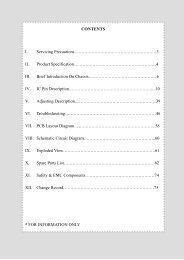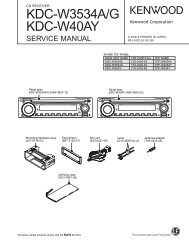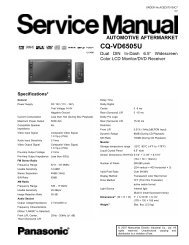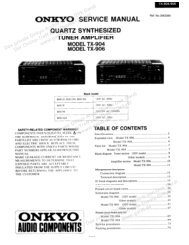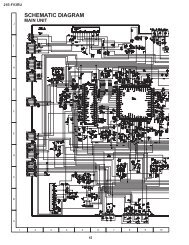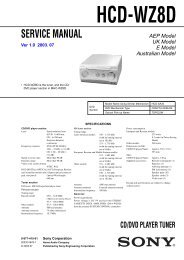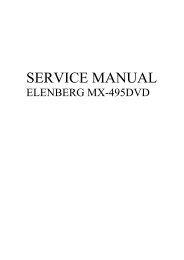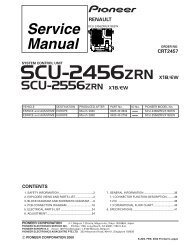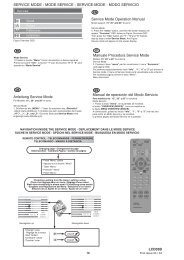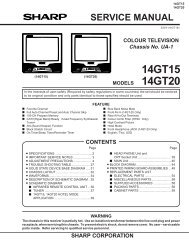Technology of Q 2500 colour TV set
Technology of Q 2500 colour TV set
Technology of Q 2500 colour TV set
You also want an ePaper? Increase the reach of your titles
YUMPU automatically turns print PDFs into web optimized ePapers that Google loves.
<strong>Technology</strong> <strong>of</strong> Q <strong>2500</strong> <strong>colour</strong> <strong>TV</strong> <strong>set</strong>According to the operating mode selection iseither with H level on blank on pins 38 and 33or controlled from the computer via the I²Cbus.In the following section <strong>of</strong> the circuit Y and<strong>colour</strong> difference signals are generated fromthe RGB signals.4.7.2 Control stagesIn the Y path the first component is a circuitfor gamma correction and in the <strong>colour</strong> differencebranch the <strong>colour</strong> saturation <strong>set</strong>tingstage.After RGB has been generated again from thedifference signals and the Y signal, the <strong>set</strong>tingstages for contrast and brightness arereached.The control stages for contrast and <strong>colour</strong>saturation in the other IC's are <strong>set</strong> to maximumand have no function. There is, in addition,in each channel, a <strong>set</strong>ting stage for thewhite value, and the black value is <strong>set</strong> with theamplifier stages that follow.The white value and the basic <strong>set</strong>ting <strong>of</strong> theblack value are determined in the two correspondingpositions <strong>of</strong> the service mode. Infurther a operation the black value is determinedby the cut <strong>of</strong>f control.The RGB signals are output at a maximum <strong>of</strong>3.5 Vss via pins 40, 41 and 42.The measured values for cut <strong>of</strong>f and leakagecurrent are fed to the IC on pin 44. With theevaluation circuits for leakage current and cut<strong>of</strong>f, together with the computer, subsequentadjustment is carried out via the output amplifier,in order to keep the picture impressionstable independently <strong>of</strong> aging.Pin 43 is connected to the base <strong>of</strong> the diodesplit transformer. The circuit integrated intothe IC thereby receives information about thebeam current flowing into the c.r.t.If the maximum permissible value is exceededthere, the circuit reduces the contrast and thebrightness with the corresponding controlstages. (see basic board “Beam current limitation“).4.7.3 I²C bus interface and raster correctionAll control processes such as brightness, contrast,etc are controlled via pins 10 and 11 <strong>of</strong>the I²C bus interface. In addition, a DAC canalso be controlled via the I²C bus. For this,TDA 9332 on pin 25 outputs an adjustablevoltage. This is fed to the rotation panel on pin3 <strong>of</strong> connector W 1021. At this point an additionalcoil on the tube turns the deflectionraster, thus providing compensation <strong>of</strong> theearth’s magnetic field at the installation site <strong>of</strong>the device. The value <strong>of</strong> the raster correctioncan <strong>set</strong> in both service mode and in the menufor picture functions.If the device is turned, the influence <strong>of</strong> theearth’s magnetic field changes. The plannedrotatable rack takes this into account. Therack is controlled from the chassis, with therotation angle being determined by the <strong>TV</strong>s<strong>of</strong>tware. Raster correction can also be determined,in that on rotation the voltage on pin26 <strong>of</strong> TDA 9332 is changed.The influence <strong>of</strong> the rotation angle on theraster displacement is almost linear. On installation<strong>of</strong> the device, it is sufficient for correctfunctioning <strong>of</strong> the correction to input a valuefor raster correction into the EAROM for thecentre and the two end stops.4.8 Picture in pictureOn the signal board an optional picture in picturecircuit is possible. This circuit consists <strong>of</strong>the video processorDocument Q <strong>2500</strong> 105 © Loewe ProCollege



